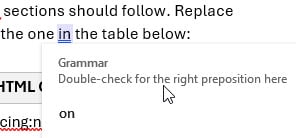I previously wrote a blog series about how editors can help, and when it comes to a number of the tasks I discussed in that series, sometimes the response is “AI can do that”. While AI is becoming more prominent, and admittedly more sophisticated, and can be helpful in certain situations, I would also caution against using it for editorial or content creation tasks without at least some form of oversight, whether that’s from a writer or an editor. Here’s why.
AI can miss the context
For many years now, we’ve seen AI products designed to help you edit your work. Some may find it helpful for performing spelling and grammar checks on emails or other documents. If used properly, it can be a helpful tool – as long as you consider each of its suggestions critically to ensure they are correct. In my experience, these tools can often miss the overall context of the sentence and suggest “corrections” that are either not as clear/concise or that are actually incorrect. It also may not pick up on mistakes like incorrect word choice or sentences that aren’t communicating the intended meaning correctly. So, if you’re looking for more than a brief check for typos, a professional editor will provide better results.
For example, in the sentence below, the grammar check tool is suggesting I change “in” to “on” because it looks at the word “table” and decides I have used the wrong preposition – mistaking this “table” for a physical one and completely ignoring the context of having a table within the document.

AI isn’t consistent
I’ve played around with an AI tool to see if it could be helpful in certain situations (see below), but something I’ve noticed is that it isn’t consistent. One of my jobs as an editor is to ensure that the documents we produce are consistent across the board, including aspects like word choice and sentence structure. When given the same prompt for different pieces of text, the results I received back left a lot to be desired in this area – even being inconsistent within the same paragraph or set of steps.
AI also won’t ensure that your documents are consistent with each other and with your company’s branding and style guide. If you have multiple employees producing documents, whether making use of AI tools or not, you will have issues with consistency unless you have someone, like an editor, providing oversight on all of your documentation.
AI can be wrong
As mentioned above, sometimes the suggestions produced by AI tools are simply incorrect. If you are using AI to write content for you, you will need to make sure that anything it produces is factually correct, especially if it is information you will be sending to your consumers.
It also won’t catch errors in content like product specifications or operating instructions. Even if you have subject matter experts creating your copy, they can still make mistakes. A knowledgeable editor is trained to spot these errors and catch mistakes, where an AI tool wouldn’t.
Intellectual property and copyright
Concerns about intellectual property and copyright regarding AI-generated content is a bigger topic, that is beyond the scope of this blog, but to any company considering the use of AI for editing, I strongly recommend that you conduct thorough research on this topic. There are certainly challenges in this area that should be carefully evaluated before you make the decision to use AI in any significant capacity.
Where can AI tools help?
While I am firmly against using AI as a replacement for an editor, there are some functions it can perform that I think could be useful.
In certain meeting platforms, like Microsoft Teams, AI tools can be used to create a transcript and a summary of a recorded meeting. This can be helpful if you need to confirm what was discussed or find a particular point in the meeting to go back to for review.
Other tools like Copilot can be helpful to create summaries or lists. If you are already familiar with the content, using an AI tool to create a summary of long documents or a bulleted list of notes can save you time as the main points can be pulled out without having to reread the entire document, then reviewed to ensure they cover the points you want them to.
In these and other cases where AI could be useful, I want to stress that anything produced by these tools should always be reviewed carefully, especially if they are going to be used in a customer- or client-facing situation. Anything being used outside of a personal/private context needs to be looked at with a critical eye to ensure the quality is up to your company’s standards.
The role of an editor is to ensure your content is consistent, concise, and clear, while making it as error-free as possible. While AI tools can be helpful in certain situations, my experience is that they struggle to produce content to the same standards as a professional editor, especially in these areas.
About the Author
Follow on Linkedin More Content by Breanne MacDonald























